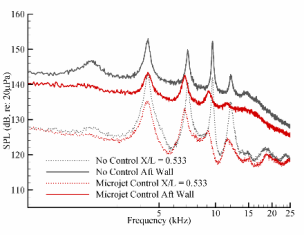
AAPL
Advanced Aero Propulsion Laboratory
Imagination is more important than knowledge. For knowledge is limited to all we now know and understand, while imagination embraces the entire world, and all there ever will be to know and understand.
—Albert Einstein Shadowgraph of Mach 1.5 flow over an open cavity
Shadowgraph of Mach 1.5 flow over an open cavity
Current research using the Supersonic Wind Tunnel has been focused on the understanding and control of supersonic cavity flow. DARPA, Boeing, and AFRL have sponsored projects with the goal of reducing the unsteady pressure loads within a variety of different cavities. Experimental research preformed in the lab has shown that the use of supersonic microjets can greatly reduce the flow induced resonance with minimum mass flux. Small (400µm) jets are flush mounted on the leading edge of the cavity, perpendicular to the free-stream flow. A number of jet configurations have been attempted, with the current optimum arrangement having the jets equally spaced along the entire width of the cavity.
|
Dramatic results have been achieved, with up to 8dB reduction in surface pressureloads. Velocity field measurements have shown the highly unstable shear layer that ‘flaps’ over the cavity, the flapping of the shear layer causes additional fluid to enter the cavity setting up a large recirculation region as well as the high unsteady pressure loads. With the microjet control the shear layer grows much more rapidly and is shifted out of the cavity, thus reducing the unsteadiness within the cavity. |
 Effect of Microject Control on Mach 1.5 open rectangular cavity flow |
 Shadowgraph of 400µm Microjets at different stagnation pressures
Shadowgraph of 400µm Microjets at different stagnation pressures